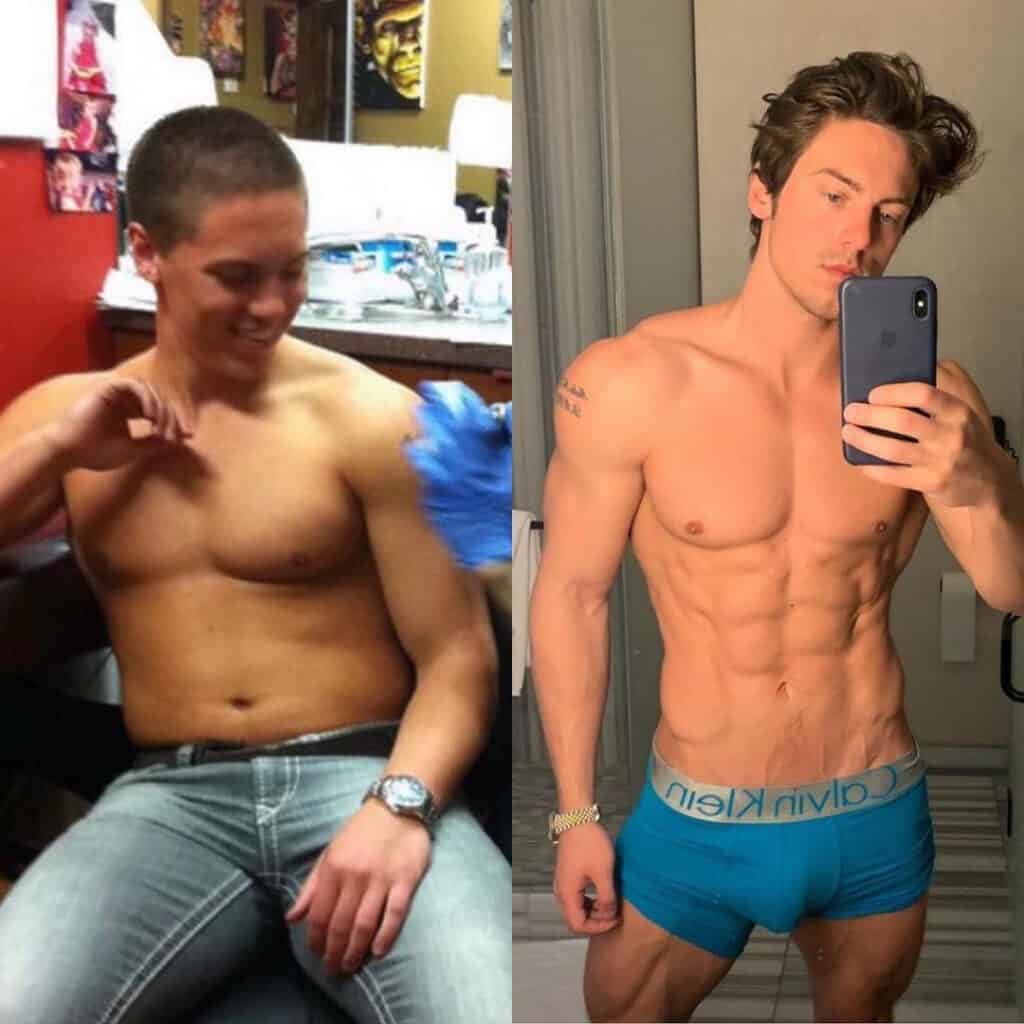What is a lean bulk? It sounds almost like an oxymoron. How can you build muscle and lean up at the same time?
This isn’t possible according to conventional wisdom – which is indeed the case if you follow the traditional bulking diet where you eat massive amounts of food in building muscle. Of course, people who follow this diet end up with muscle that’s buried in the mounds of fat they gained along the way.
Here’s the good news: bulking up while staying lean is highly possible – even easy – if you train and eat the Kinobody way.
The Traditional Lean Bulk Method Explained
For those new to the lifting game, let’s take a minute to explain how conventional lean bulking programs work. Training and dieting is broken into two phases: the bulk phase and the lean fat loss phase. During the former, lifters up their calories, usually starting 500 calories above baseline. From there, they gradually up the calories, usually by another 500 or so every one to two weeks.
Some people consume as much as 5,000 to 6,000 calories a day at the peak of their bulk phase. As long as you’re putting in the sweat in the gym, you’ll definitely see some muscle gain. Unfortunately, you also get fatter along the way.
Essentially, you take on the physique akin to a powerlifter, or a body shape similar to Maui from the Disney film Moana (the character voiced by Dwayne Johnson).
Once lifters gained the desired muscle mass, they transition to a fat loss phase where they incorporate cardio and gradually decrease calories the same way they added calories while bulking up.
The traditional bulking diet is often pushed to people who consider themselves “hardgainers.” These are men who are naturally thin. By thin, think of actor DJ Qualls.
What’s Wrong with Bulking Up?

We’re not badmouthing the conventional bulking diet. If you’re okay with looking bloated with chubby cheeks and fat fingers for several months, then have at it. However, if you want to stay lean like a Kinobody Warrior while slowly inching your way in muscle mass, then you need another approach.
Another issue with bulking up is that you risk losing much of the hard-earned muscle once you transition to the fat loss phase. Due to incorrect training and/or calorie intake, most lifters end up back in square one with roughly the same amount of muscle and body fat as they did when they started.
Lean Bulking the Kinobody Way

Despite what the naysayers and traditionalists say, gaining muscle without fattening up is possible if you follow the right muscle gain diet and training regimen. Under a healthy lean bulk program, you’ll add just enough calories to put on muscle minus the fat.
The process is also a steady one, taking place over the course of several months. Don’t expect to look like Vin Diesel or Hugh Jackman in 60 days. However, you will stay lean the whole duration. You won’t feel inclined to put on a baggy sweater to hide the increased girth around your belly.
If done correctly, you shouldn’t gain more than one pound of fat per month. Even then, you would have put on enough lean muscle to retain a fairly solid physique.
How Long is a Lean Bulk Phase?
A lean bulk should last a minimum of four months and as long as eight months. If done correctly, you should gain about two pounds of muscle per month. For beginners and those returning from a lengthy layoff, you can extend this to a full year or even two years. Research actually shows that beginners can put on up to 20 pounds of muscle in their first year of heavy lifting. You won’t reach that maximum gain if you continually return to cutting every few months.
If you follow this protocol, then the muscle to fat gain ratio should be 2:1 at the most. The muscle growth may taper down a bit in the later months.
Some people want to stay as lean as possible and may only try to lean bulk for two to three months. We stand by the four-month minimum rule. What’s the point, after all, of putting on just two to four pounds of muscle?
The point here is this: Don’t be afraid of a little fat gain.
We can’t emphasize this enough. Some Kinobody followers started the program to lose weight. Once they leaned down, however, they become hesitant to transition to lean bulking because they’re so afraid of gaining back even an ounce of fat.
Please scrub these fears from your conscience.
The Kinobody Muscle Gain Diet
Okay, here’s the meat and potatoes with information you can put into practice. During a lean bulk, you’re going to eat 500 calories above your baseline. You will do this for three weeks straight followed by one week of eating at baseline levels.
The baseline is the number of calories required to maintain your current weight. To determine your maintenance level, simply multiply your bodyweight in pounds by 15. In other words, if you weigh 170, your baseline daily calorie intake would be 2,550. When eating 500 calories above baseline, you would consume 3,050 calories a day.
The simplest way to go about this process is to eat 500 calories above baseline for the first three weeks of every month and switch to the baseline level for the fourth and final week. Rinse and repeat at the start of the new month.
What About Protein and Carbs?

Protein to carb ratios is also where we differ from conventional muscle gain diet plans. Typical bodybuilding literature advocates consuming 1.5 to 2 grams of protein per pound of bodyweight. This is excessive and frankly it’s just a ruse to get you to buy expensive whey protein supplements.
Keep your protein intake between .8 and 1 gram per pound of bodyweight. Percentage-wise, ratios should be about 25% to 30% protein, 25% to 30% fat, and the rest allotted to carbs.
Unlike conventional programs, we don’t advocate a low carb diet. Carb restriction causes cortisol increase. In turn, that inhibits testosterone production. This is also why we advise against too much protein consumption. More protein means less space on the dinner plate for carbs.
Try Lean Bulking for Yourself
Instead of taking our word for it, try Kinobody yourself. All of our programs are designed for long-term use to stay lean and muscular all year-round. Of course, we only discussed the dieting portion. For a lean bulking workout, we recommend either the Greek God or Superhero training program for putting on lean mass – all while training heavy only three times per week.
What’s the difference in these two programs?
The Greek God Program shows you how to build a body with dense, proportionate muscle mass while maintaining a solid level of definition. Imagine the sleek, “built” celebrity look rather than bulky like a bodybuilder – the look of Brad Pitt in Troy, or Stephen Amell in Arrow.
Click here to check out the Greek God Program.
The Superhero Bulking Program teaches you how to rapidly put on muscle with aesthetic proportion to achieve the muscular “Hollywood Physique” like Henry Cavill in Man of Steel, or Chris Hemsworth in Thor.





